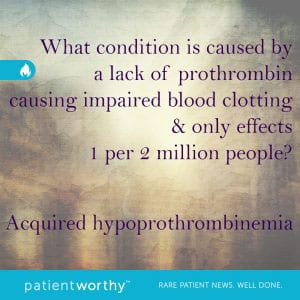Hypoprothrombinemia
Well, what is (acquired) hypoprothrombinemia?
Hypoprothrombinemia is a bleeding disorder, caused by a lack of the protein prothrombin, which helps with blood clotting. It comes in two forms: inherited and acquired.
Unlike its inherited form, people develop acquired hypoprothrombinemia (also known as acquired prothrombin deficiency or acquired factor II) because of another condition or some kind of isolated factor deficiency. (Vitamin K deficiency is a common culprit.) The body needs vitamin K to produce prothrombin in liver cells. Without it, people experience clotting failures and prolonged bleeding. However, thanks to vitamin K injections given before birth, this form of hypoprothrombinemia remains relatively rare, though still less rare than its inherited counterpart.
Acquired hypoprothrombinemia is often autoimmune in nature and has connections to the anti-clotting lupus anticoagulant antibodies.
What are the symptoms of acquired hypoprothrombinemia?
Like other bleeding disorders, acquired hypoprothrombinemia symptoms are the result of hemorrhaging—most often manifesting as mucosal (mucus membrane) and soft tissue bleeding. In the case of acquired hypoprothrombinemia, these hemorrhages can be deep, involving instances of intracranial bleeding and muscle hematomas.
Other, common acquired hypoprothrombinemia symptoms include:
- Easy bruising
- Gum bleeds
- Extensive bleeding during surgery, tooth pulls, and/or injury
How is acquired hypoprothrombinemia diagnosed?
Getting an acquired hypoprothrombinemia diagnosis largely revolves around ruling out other potential causes of the condition’s main component: prothrombin deficiency.
To effectively discover whether the deficiency originates with acquired hypoprothrombinemia, doctors can test for factor II activity. If the test finds an isolated factor II deficiency, it’s a strong indicator for acquired hypoprothrombinemia. Additional testing for inhibitors (antibodies that, in bleeding disorders, mistakenly bind to clotting factors and limit bleeding control) can provide more definitive evidence of the diagnosis.
Doctors may want to try other differential methods, such as bleeding tests, but these don’t give relevant information for acquired hypoprothrombinemia and won’t lead to a proper answer.
What are the available treatments for acquired hypoprothrombinemia?
When it comes to acquired hypoprothrombinemia treatment, the first goal is always to control the bleeding.
Many treatments exist that can give the body the prothrombin it’s lacking. Frozen plasma and prothrombin-complex concentrate are two such treatments. However, products that contain prothrombin may also have other factors that can cause complications. It’s always best to manage and discuss treatment with a trusted healthcare professional.
For those with a vitamin K deficiency, the vitamin K itself can be a treatment option. As for prophylactic treatment, the possibility remains controversial, and surgery should be avoided.
Outside of medical intervention, being aware of potentially risky behaviors and activities, and limiting them, can help control bleeds in day-to-day life.
Where can I find more information about acquired hypoprothrombinemia?
Hypoprothrombinemia Articles

Trading Tennis for Books: How Hypoprothrombinemia Changed Her Life







